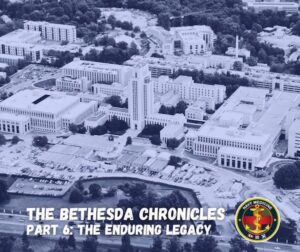By the 1990s, the National Naval Medical Center (NNMC) in Bethesda and Walter Reed Army Medical Center in Washington, D.C., stood as two of the world’s largest military hospitals – medical standard-bearers for the U.S. Navy and Army, respectively. At the time, few could have foreseen their eventual unification under a single entity. The 2005 Base Realignment and Closure (BRAC) initiative made this a surprising reality.
The 2005 BRAC completely reorganized military healthcare in the National Capital Region (NCR) by co-locating both medical facilities in Bethesda under the banner of, what would be known as, the Walter Reed National Military Medical Center (WRNMMC). According to the recommendations in the BRAC Report of 2005, the new military medical center would “provide enhanced visibility, as well as, recruiting and retention advantages to the Military Health System [MHS].”
Overseeing this historic merger was a newly created entity called the Joint Task Force (JTF), National Capital Region (NCR) Medical, which had been established the Deputy Secretary of Defense Gordon Englund in September 2007. Former Navy Deputy Surgeon General, Vice Adm. John Mateczun was selected to lead the historic merger as the JTF Commander. It was a job that was once likened to having to combine the New York Yankees and Boston Red Sox baseball teams and renaming Fenway Park “Derek Jeter Stadium.”
Mateczun later put the role of the Task Force in perspective by stating: “[It’s] a big job, with a lot of construction, outfitting, transition planning, training and movement, and sometimes the details seem overwhelming. But when it all seems like too much, as it does on some days, we remember our focus, keeping America’s covenant with these Wounded Warriors and their families. . . we have no higher priority, and these medical construction projects are testimony to that commitment.”
As the merger was taking place, and Walter Reed’s tertiary care functions were transferring over to Bethesda, the vital role of the medical center in caring for the sick and wounded did not stop.
While serving as the Commander of the National Naval Medical Center during these years, Rear Adm. (later Vice Adm.) Matthew Nathan helped oversee a successful transition and ensure the ambitious merger was executed properly without disruption of services to active and retired military and their families. This was no easy task and Nathan’s first day on the job was, as he put it, “when they put the first shovel in the ground.”
The Bethesda campus became the site of massive construction and renovation harkening back to 1942. Buildings that had been standing since then were torn down and gutted. Wards and ICUs were closed and relocated to temporary spaces. And while all these pieces were shifting, the war in Afghanistan was at its zenith, and casualties—some just days from the battlefield—were flooding into the hospital. As Nathan later described that period, “The casualty counts coming in were just incalculable. Critically injured warriors were arriving in the middle of the massive construction project. I had a great team of Army and Navy personnel who worked for me. We got the warriors taken care of. We got the Joint Command stood up.”
And the mission was a success.
The new Walter Reed National Military Medical Center was officially stood-up on August 27, 2011. A month later Admiral Nathan was selected to be the 37th Surgeon General of the Navy.
Even as the Bethesda medical complex expanded, the U.S. military remained engaged in Iraq and Afghanistan. Combat casualty care and warfighter support stayed paramount for service medical departments. Thousands of casualties poured into Bethesda from the war zones.
Traumatic brain injury (TBI) and post-traumatic stress disorder (PTSD) emerged as major challenges for the military during this period. Medical personnel at Bethesda, including Navy, Army, and civilians, became pioneers in understanding these conditions’ impact and developing treatment approaches. They emphasized continuity of care, ensuring consistent support throughout recovery.
The Navy helped spearhead the creation of innovative DoD organizations like the National Intrepid Center of Excellence (NICoE), co-located with Walter Reed National Military Medical Center. NICoE focused on treatment planning, research, and education for service members and their families dealing with the complex interplay between mild TBI and psychological health conditions. And it could be said that NICoE’s role further underscored the mission and overall legacy of Bethesda.
Through its name changes, one thing has remained constant at Bethesda over the years: its unwavering dedication to healing. Whether known as the National Naval Medical Center, the President’s Hospital, or Walter Reed National Military Medical Center—and whether serving as the preeminent teaching hospital or as an innovation hub—Bethesda has always served as a beacon of hope and recovery.
This enduring legacy resonates deeply with those who have served in Military Medicine, which is why Secretary Carlos Del Toro aptly named the new class of Expeditionary Medical Ships (EMS) after Bethesda—truly, a fitting tribute to this historic center of healing.
And for the Navy Medical Department whose historical links to Bethesda are deeply rooted, the new namesake-class ships could be called a fitting tribute to all those who have dedicated themselves to service at the medical center throughout its proud history.
As Rear Adm. Darin Via, the Navy’s 40th Surgeon General, remarked at the USNS Bethesda dedication ceremony on January 8, 2024:
“The naming of the USNS Bethesda remains a testament to our unwavering commitment to the well-being of our forces. It symbolizes the strength, resilience, and compassion that our great Navy exemplifies.”
Sources:
Defense Base Closure and Realignment Commission Report to President (2005). Accessed from: https://www.acq.osd.mil/brac/docs/BRAC-2005-Commission-Report.pdf
Mateczun, John, Vice Adm. Oral History. (Conducted by A.B. Sobocinski). Sessions conducted on October 18, November 13, and December 12, 2019.
Nathan, Matthew, Vice Adm. Legacy Session. (Conducted by A.B. Sobocinski). Session conducted November 18, 2015.
Sobocinski, A.B. (2022, Nov 14). Remembering Vice Admiral John Mateczun—Navy Psychiatrist, Visionary and Stalwart Leader of Military Medicine. DVIDS. Accessed from: https://www.dvidshub.net/news/433239/remembering-vice-admiral-john-mateczun-navy-psychiatrist-visionary-and-stalwart-leader-military-medicine-1946-2022
Via, D. (2024, Jan 8). Remarks delivered at USNS Bethesda Dedication Ceremony.
